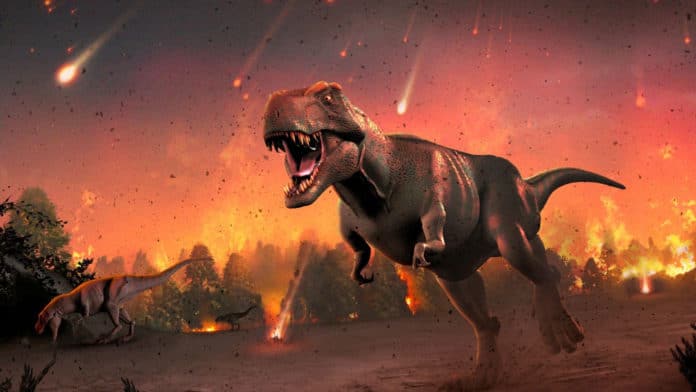For decades, the prevailing dinosaur extinction theory suggests that an asteroid slammed into the planet, causing cataclysmic devastation that wiped out most life on the planet. This Chicxulub impact releases a massive amount of sulphur.
A new study by the Universities of St Andrews and Bristol in collaboration with Syracuse University (New York, US) and Texas A&M explored the consequences of this asteroid impact. Scientists found evidence that the impact ejected sulphur gases into the Earth’s atmosphere.
The gases circulated globally for years in the Earth’s atmosphere, cooling the climate and contributing to the mass extinction of life. This extinction was disastrous for dinosaurs and other life as well. At the same time, it allowed the diversification of mammals, including primates.
Sulfate aerosols have long been implicated as a primary forcing agent of climate change and mass extinction after the end-Cretaceous Chicxulub bolide impact. However, uncertainty remains regarding the quantity, residence time, and degree to which impact-derived sulfur transited the stratosphere, where its climatic implications would have been maximized.
Dr. James Witts of the School of Earth Sciences at the University of Bristol said, “Our data provide the first direct evidence of mass-independent fractionation of sulfur isotopes (S-MIF) preserved in Chicxulub impact ejecta materials deposited in a marine environment in the Gulf Coastal Plain of North America.”
Dr. Aubrey Zerkle of the School of Earth and Environmental Sciences at the University of St Andrews explained: “One reason this particular impact was so devastating to life seems to be that it landed in a rich marine environment rich in sulphur and other volatiles. The dinosaurs were just really unlucky!”
“We examined rare sulphur isotopes in material ejected by the impact and deposited in a nearby seat, now represented by rocks found along the Brazos River in Texas.”
Christopher Junium of the Department of Earth and Environmental Sciences at Syracuse University said, “Atmospheric sulphur in the stratosphere scattered incoming solar radiation and prolonged planetary-scale cooling for many years after the original impact, causing acid rain and reducing the light available for photosynthesis which is vital for plant life and marine plankton that form the base of the food chain.”
“The initial effects of the impact were caused by rock dust, soot, and wildfires, but the sulphur aerosols extended the time period over which life would have suffered from extreme cooling, reduced sunlight, and acidification of the land surface and oceans. And it was this extended duration of cooling that likely played a central role in the severity of the extinction.”
Journal Reference:
- Christopher K. Junium et al. Massive perturbations to atmospheric sulfur in the aftermath of the Chicxulub impact. DOI: 10.1073/pnas.2119194119
